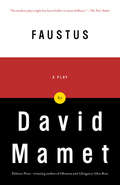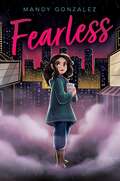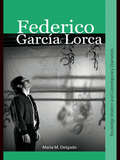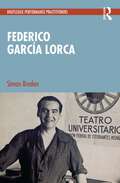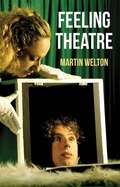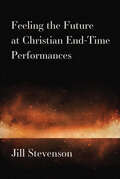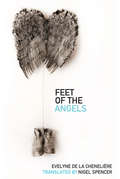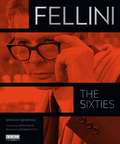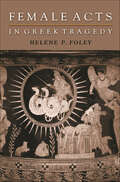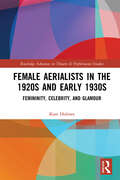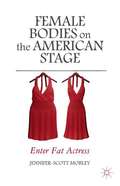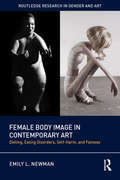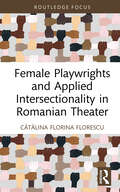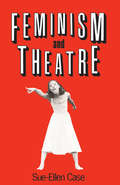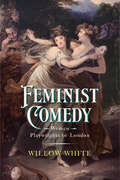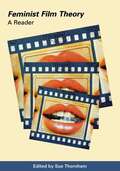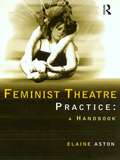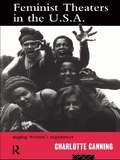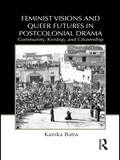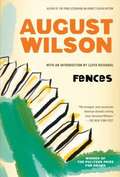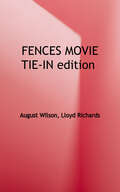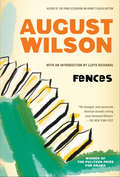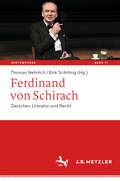- Table View
- List View
Faustus
by David MametHaving put his personal stamp on the contemporary theater, David Mamet now performs the supremely audacious feat of reinventing the theater of the past. He does so by telling his own ingenious and eerily moving version of the tragedy of Dr. Faustus. Mamet's Faustus--like Marlowe's and Goethe's before him--is a philosopher whose life's work has been the pursuit of "the secret engine of the world." He is also the distracted father of a small, adoring son. Out of the clash between love and intellect and the fatal operation of Faustus' pride, Mamet fashions a work that is at once caustic and heart-wrenching and whose resplendent language marries metaphysics to conman's patter. A meditation on reason and folly, fathers and sons, and a breathtaking display of magic both literal and theatrical, Faustus is a triumph.
Fearless (Fearless Series #1)
by Mandy GonzalezBetter Nate than Ever meets Love Sugar Magic in this spooky middle grade novel from Hamilton and Broadway star Mandy Gonzalez about a group of young thespians who must face the ghost haunting their theater.Twelve-year-old Monica Garcia has arrived in NYC with her grandmother and a few suitcases to live her dream on Broadway. She&’s been chosen as understudy to the star of Our Time, the famed Ethel Merman Theater&’s last chance to produce a hit before it shutters its doors for good. Along with her fellow castmates—a.k.a. &“the squad&”—Monica has a big and very personal reason to want this show to succeed. But rumors of a long-running curse plague the theater. And when strange and terrible things start to threaten their hopes for a successful opening night, Monica and the rest of the squad must figure out how to reverse the curse before their big Broadway debuts. With the help of her new friends, her family, and a little magic, can Monica help save the show—and save their dreams? From Broadway and television star Mandy Gonzalez comes a story about what it means to dream, be yourself, and be fearless.
Federico García Lorca (Routledge Modern and Contemporary Dramatists)
by Maria M. DelgadoImmortalized in death by The Clash, Pablo Neruda, Salvador Dalí, Dmitri Shostakovich and Lindsay Kemp, Federico García Lorca's spectre haunts both contemporary Spain and the cultural landscape beyond. This study offers a fresh examination of one of the Spanish language’s most resonant voices; exploring how the very factors which led to his emergence as a cultural icon also shaped his dramatic output. The works themselves are also awarded the space that they deserve, combining performance histories with incisive textual analysis to restate Lorca’s presence as a playwright of extraordinary vision, in works such as: Blood Wedding The Public The House of Bernarda Alba Yerma. Federico García Lorca is an invaluable new resource for those seeking to understand this complex and multifaceted figure: artist, playwright, director, poet, martyr and in the eyes of many, Spain’s ‘national dramatist’.
Federico García Lorca (Routledge Performance Practitioners)
by Simon BredenLauded as one of the most important poets and playwrights of the twentieth century, Federico García Lorca was also an accomplished theatre director with a clear process and philosophy of how drama should be staged. Directing both his own work and that of others, Lorca was also closely involved in the rehearsals for productions of many of his plays, and from his own writings and those of his collaborators, a determined agenda to stimulate audiences and renovate theatre can be seen.This is the first book in English to fully consider Lorca as a director and his rehearsal methodology. The book combines:- A biographical account of Lorca’s work as a director and rehearsal leader, revealing his techniques and methods of approach texts;- An exploration of his key writings on and around theatre, drawing on his talks, play introductions, and some of the dramatic works themselves;- The first translation into English of his fragment Dragón;- A detailed discussion of Lorca’s key productions, Lope de Vega’s Fuente Ovejuna (1933) for La Barraca, and his own Yerma (1934).- Specific focus on the practical applications that we can draw from Lorca’s methods, both from what survives of his own work and from the accounts of his close collaborators.As a first step towards critical understanding, and as an initial exploration before going on to further, primary research, Routledge Performance Practitioners offer unbeatable value for today’s student.
Feeling Theatre
by Martin WeltonWhy is it that in going to see plays we are also touched or moved by them, and is there more than metaphor involved in such claims? Considering these and other questions, this book examines a range of contemporary performance works in which performers and their audiences occupy a shared realm of feelings, in which the play is not always the thing.
Feeling the Future at Christian End-Time Performances
by Jill C StevensonThe End is always near. The Apocalypse has sparked imaginations for millennia, while in more recent times, highly publicized predictions have thrust End-Time theology briefly into the spotlight. In the 21st century, fictional depictions of various apocalyptic scenarios are found in an endless stream of films, TV shows, and novels, while real-world media coverage of global issues including climate change and the migrant crisis often features an apocalyptic tone. Feeling the Future at Christian End-Time Performances explores this prevalent human desire to envision the End by analyzing how various live End-Time performances allow people to live in and through future time. ? The book’s main focus is contemporary Christian End-Time performances and how they theatrically construct encounters with future time—not just images or ideas of a future, but viscerally and immediately real experiences of future time. Author Jill Stevenson’s examples are Hell Houses and Judgement Houses; Rapture House, a similarly styled “walk through drama” in North Carolina; Hell’s Gates, an “outdoor reality drama” in Dawsonville, Georgia; Ark Encounter, a full-size recreation of Noah’s Ark; and Tribulation Trail, an immersive thirteen-scene drama ministry based on the Book of Revelation. The book’s coda considers similarities between these Christian performances and secular survivalist prepper events, especially with respect to constructions of and language about time. In doing so, the author situates these performances within a larger tradition that challenges traditional secular/sacred distinctions and illuminates how the End Times has been employed in our current social and political moment.
Feeling the Future at Christian End-Time Performances
by Jill C. StevensonThe End is always near. The Apocalypse has sparked imaginations for millennia, while in more recent times, highly publicized predictions have thrust End-Time theology briefly into the spotlight. In the 21st century, fictional depictions of various apocalyptic scenarios are found in an endless stream of films, TV shows, and novels, while real-world media coverage of global issues including climate change and the migrant crisis often features an apocalyptic tone. Feeling the Future at Christian End-Time Performances explores this prevalent human desire to envision the End by analyzing how various live End-Time performances allow people to live in and through future time. The book’s main focus is contemporary Christian End-Time performances and how they theatrically construct encounters with future time—not just images or ideas of a future, but viscerally and immediately real experiences of future time. Author Jill Stevenson’s examples are Hell Houses and Judgement Houses; Rapture House, a similarly styled “walk through drama” in North Carolina; Hell’s Gates, an “outdoor reality drama” in Dawsonville, Georgia; Ark Encounter, a full-size recreation of Noah’s Ark; and Tribulation Trail, an immersive thirteen-scene drama ministry based on the Book of Revelation. The book’s coda considers similarities between these Christian performances and secular survivalist prepper events, especially with respect to constructions of and language about time. In doing so, the author situates these performances within a larger tradition that challenges traditional secular/sacred distinctions and illuminates how the End Times has been employed in our current social and political moment.
Feet of the Angels
by Nigel Spencer Evelyne de la ChenelièreEver since her brother's untimely death, Marie has been fascinated with angels, believing her brother has become one. Now as a young woman, she has dedicated her doctoral thesis to the subject: the sudden portrayal of angels with feet in Renaissance paintings. As Marie tries to analyze the motive behind this, she begins to uncover questions of existentialism, societal perceptions of women, and the meaning of art and life. Her biggest challenge, though, becomes grasping a seemingly impossible understanding of her brother's suicide, and dealing with her own dislocation.
Fellini: The Sixties (Turner Classic Movies)
by Manoah Bowman Foreword by Anita Ekberg Afterword by Barbara Steele Photographic Editor David Wills Designed by Stephen SchmidtStyle. Beauty. Passion. Vision. These are just a few of the words often used to describe the films of the single most celebrated director in Italy, and one of the most important directors the world has ever known--Federico Fellini. Fifty years since their initial releases, his films of the 1960’s still inspire, shock and delight. More than just encapsulating the 1960’s, these films also helped define the style of the decade. With a staggering twelve Academy Award nominations between his four feature films during this period, Fellini reached the heights of fame, film artistry, and worldwide prominence. Studied, analyzed and re-released over the years, these films continue to amaze each new generation that discovers them. Their impeccable style makes them timeless. Their images make them unforgettable. Their passion brings them to life. And their singular vision makes them unique in all of cinema. Fellini: The Sixties is a stunning photographic journey through the director’s most iconic classics: La Dolce Vita, 8½, Juliet of the Spirits, and Fellini Satyricon. Carefully selected imagery from the Independent Visions photographic archive, many published here for the first time, illuminate these films as they have never been seen before, and reveal fascinating details of the director’s working style and ebullient personality. With more than 150 photographs struck from original negatives, these images spring to life from the page with the depth and quality of the films themselves. Complemented with insightful essays from contemporary writers, Fellini: The Sixties is a true testament to the man and his work, a remarkable compendium to the legendary filmmaker’s greatest achievements.
Female Acts in Greek Tragedy (Martin Classical Lectures #15)
by Helene P. FoleyAlthough Classical Athenian ideology did not permit women to exercise legal, economic, and social autonomy, the tragedies of Aeschylus, Sophocles, and Euripides often represent them as influential social and moral forces in their own right. Scholars have struggled to explain this seeming contradiction. Helene Foley shows how Greek tragedy uses gender relations to explore specific issues in the development of the social, political, and intellectual life in the polis. She investigates three central and problematic areas in which tragic heroines act independently of men: death ritual and lamentation, marriage, and the making of significant ethical choices. Her anthropological approach, together with her literary analysis, allows for an unusually rich context in which to understand gender relations in ancient Greece. This book examines, for example, the tragic response to legislation regulating family life that may have begun as early as the sixth century. It also draws upon contemporary studies of virtue ethics and upon feminist reconsiderations of the Western ethical tradition. Foley maintains that by viewing public issues through the lens of the family, tragedy asks whether public and private morality can operate on the same terms. Moreover, the plays use women to represent significant moral alternatives. Tragedy thus exploits, reinforces, and questions cultural clichés about women and gender in a fashion that resonates with contemporary Athenian social and political issues.
Female Aerialists in the 1920s and Early 1930s: Femininity, Celebrity, and Glamour (Routledge Advances in Theatre & Performance Studies)
by Kate HolmesFemale solo aerialists of the 1920s and early 1930s were internationally popular performers in the largest live performance mass entertainment of the period in the UK and USA. Yet these aerialists and this period in circus history have been largely forgotten despite the iconic image of ‘the’ female aerialist still flaring in the popular imagination. Kate Holmes uses insights gained as a practitioner to reconstruct in detail the British and American performances and public personae of key stars such as Lillian Leitzel, Luisita Leers, and the Flying Codonas, revealing what is performed and implicit in today’s practice. Using a wealth of original sources, this book considers the forgotten stars whose legacy of the cultural image of the female aerialist echoes. Locating performers within wider cultural histories of sport, glamour, and gender, this book asks important questions about their stardom, including: Why were female aerialists so alluring when their muscularity challenged conservative ideals of femininity and how did they participate in change? What was it about their movements and the spaces they performed in that activated such strong audience responses? This book is vital reading for students and practitioners of aerial performance, circus, gender, popular performance, and performance studies.
Female Bodies on the American
by Jennifer-Scott MobleyThe fat female body is a unique construction in American culture that has been understood in various ways during the twentieth and early twenty-first centuries. Analyzing post-WWII stage and screen performances, Mobley argues that the fat actress's body signals myriad cultural assumptions and suggests new ways of reading the body in performance.
Female Body Image in Contemporary Art: Dieting, Eating Disorders, Self-Harm, and Fatness (Routledge Research in Gender and Art)
by Emily L. NewmanNumerous contemporary artists, particularly female artists, have chosen to examine the idealization of the female body. In this crucial book, Emily L. Newman focuses on a number of key themes including obesity, anorexia, bulimia, dieting, self-harm, and female body image. Many artists utilize their own bodies in their work, and in the act of trying to critique the diet industry, they also often become complicit, as they strive to lose weight themselves. Making art and engaging eating disorder communities (in real life and online) often work to perpetuate the illnesses of themselves or others. A core group of artists has worked to show bodies that are outside the norm, paralleling the rise of fat activism in the 1990s and 2000s. Interwoven throughout this inclusive study are related interdisciplinary concerns including sociology, popular culture, and feminism.
Female Playwrights and Applied Intersectionality in Romanian Theater (Routledge Advances in Theatre & Performance Studies)
by Cătălina Florina FlorescuIn this collection, the author focuses on several contemporary Romanian female playwrights with residencies in Europe and the U.S.: Alexandra Badea, Carmen Francesca Banciu, Alexa Băcanu, Ana Sorina Corneanu, Mihaela Drăgan, Dr. Cătălina Florina Florescu, Dr. Mihaela Michailov, Dr. Domnica Rădulescu, Saviana Stănescu, and Dr. Elise Wilk. In their bold works, written by female playwrights who are academics, activists, and performers, we are invited to discover variations in the modus operandi of the dramatic language itself from metaphorical to matter-of-fact approaches. Furthermore, while all these playwrights speak Romanian, they also think and operate in various other languages, such as Romani, German, French, Italian, and American English. This book facilitates scholars and students to discover contemporary issues related to Romanian society as presented heavily from a feminine angle and to reveal intersectional issues as seen and applied to dramatic characters in a post-communist country from some authors who experienced communism firsthand. The book is also an invitation to reinvent how we teach dramatic literature by offering 20 interactive, exploratory activities.
Feminism and Theatre
by Sue-Ellen CaseThis classic study is both an introduction to, and an overview of, the relationship between feminism and theatre.
Feminist Comedy: Women Playwrights of London (EARLY MODERN FEMINISMS)
by Willow WhiteFeminist Comedy: Women Playwrights of London identifies the eighteenth-century comedic stage as a key site of feminist critique, practice, and experimentation. While the history of feminism and comedy is undeniably vexed, by focusing on five women playwrights of the latter half of the eighteenth century--Catherine Clive, Frances Brooke, Frances Burney, Hannah Cowley, and Elizabeth Inchbald--this book demonstrates that stage comedy was crucial to these women’s professional success in a male-dominated industry and reveals a unifying thread of feminist critique that connects their works. Though male detractors denied women’s comic ability throughout the era, eighteenth-century women playwrights were on the cutting edge of comedy and their work had important feminist influence that can be traced to today’s stages and screens.
Feminist Film Theory: A Reader
by Sue ThornhamFor the past twenty-five years, cinema has been a vital terrain on which feminist debates about culture, representation, and identity have been fought. This anthology charts the history of those debates, bringing together the key, classic essays in feminist film theory. <p><p> This book maps the impact of major theoretical developments on this growing field-from structuralism and psychoanalysis in the 1970s, to post-colonial theory, queer theory, and postmodernism in the 1990s. Covering a wide range of topics, including oppressive images, "woman" as fetishized object of desire, female spectatorship, and the cinematic pleasures of black women and lesbian women, the book is an indispensable reference for scholars and students in the field.
Feminist Theatre Practice: A Handbook
by Elaine AstonFeminist Theatre Practice: A Handbook is a helpful, practical guide to theatre-making which explores the different ways of representing gender. Best-selling author, Elaine Aston, takes the reader through the various stages of making feminist theatre- from warming up, through workshopped exploration, to performance - this volume is organised into three clear and instructive parts: * Women in the Workshop * Dramatic Texts, Feminist Contexts * Gender and Devising Projects. Orientated around the classroom/workshop, Handbook of Feminist Theatre Practice encompasses the main elements of feminist theatre, both practical or theoretical.
Feminist Theatres in the USA: Staging Women's Experience (Gender in Performance)
by Charlotte CanningFeminist Theaters in the USA is a fresh, informative portrait of a key era in feminist and theater history It is vital reading for feminist students, theater historians and theater practitioners. Their continued movement forward will be challenged and enriched by this timely look back at the trials and accomplishments of their predecessors. Canning interviews over thirty women who took part in the dynamic feminist theater of the 1970s and 1980s. They provide first-hand accounts of the excitement, struggles and innovations which formed their experience. From this foundation Cannning constructs a compelling combination of historical survey, critique and celebration which explores: * The history of the groups and their formation * The politics which shaped their work * Their methods and creative processes * The productions they brought to the stage * The reception from critics and audiences
Feminist Visions and Queer Futures in Postcolonial Drama: Community, Kinship, and Citizenship (Routledge Advances In Theatre And Performance Studies #17)
by Kanika BatraIn this timely study, Batra examines contemporary drama from India, Jamaica, and Nigeria in conjunction with feminist and incipient queer movements in these countries. Postcolonial drama, Batra contends, furthers the struggle for gender justice in both these movements by contesting the idea of the heterosexual, middle class, wage-earning male as the model citizen and by suggesting alternative conceptions of citizenship premised on working-class sexual identities. Further, Batra considers the possibility of Indian, Jamaican, and Nigerian drama generating a discourse on a rights-bearing conception of citizenship that derives from representations of non-biological, non-generational forms of kinship. Her study is one of the first to examine the ways in which postcolonial dramatists are creating the possibility of a dialogue between cultural activism, women’s movements, and an emerging discourse on queer sexualities.
Fences
by August Wilson Lloyd RichardsThe 1987 Winner of the Pulitzer Prize for Drama From August Wilson, author of The Piano Lesson and the 1984-85 Broadway season's best play, Ma Rainey's Black Bottom, is another powerful, stunning dramatic work that has won him numerous critical acclaim including the 1987 Tony Award for Best Play and the Pulitzer Prize. The protagonist of Fences (part of Wilson's ten-part "Pittsburgh Cycle" plays), Troy Maxson, is a strong man, a hard man. He has had to be to survive Troy Maxson has gone through life in an America where to be proud and black is to face pressures that could crush a man, body and soul. But the1950s are yielding to the new spirit of liberation in the 1960s. . . a spirit that is changing the world Troy Maxson has learned to deal with the only way he can. . . a spirit that is making him a stranger, angry and afraid, in a world he never knew and to a wife and son he understands less and less. . .
Fences (movie Tie-in)
by August WilsonFrom legendary playwright August Wilson comes the powerful, stunning dramatic bestseller that won him critical acclaim, including the Tony Award for Best Play and the Pulitzer Prize. Troy Maxson is a strong man, a hard man. He has had to be to survive. Troy Maxson has gone through life in an America where to be proud and black is to face pressures that could crush a man, body and soul. But the 1950s are yielding to the new spirit of liberation in the 1960s, a spirit that is changing the world Troy Maxson has learned to deal with the only way he can, a spirit that is making him a stranger, angry and afraid, in a world he never knew and to a wife and son he understands less and less. This is a modern classic, a book that deals with the impossibly difficult themes of race in America, set during the Civil Rights Movement of the 1950s and 60s. Now an Academy Award-winning film directed by and starring Denzel Washington, along with Academy Award and Golden Globe winner Viola Davis.
Fences: A Play
by August WilsonFrom legendary playwright August Wilson comes the powerful, stunning dramatic bestseller that won him critical acclaim, including the Tony Award for Best Play and the Pulitzer Prize.Troy Maxson is a strong man, a hard man. He has had to be to survive. Troy Maxson has gone through life in an America where to be proud and black is to face pressures that could crush a man, body and soul. But the 1950s are yielding to the new spirit of liberation in the 1960s, a spirit that is changing the world Troy Maxson has learned to deal with the only way he can, a spirit that is making him a stranger, angry and afraid, in a world he never knew and to a wife and son he understands less and less. This is a modern classic, a book that deals with the impossibly difficult themes of race in America, set during the Civil Rights Movement of the 1950s and 60s. Now an Academy Award-winning film directed by and starring Denzel Washington, along with Academy Award and Golden Globe winner Viola Davis.
Ferdinand von Schirach: Zwischen Literatur und Recht (Kontemporär. Schriften zur deutschsprachigen Gegenwartsliteratur #17)
by Erik Schilling Thomas NehrlichFerdinand von Schirach war lange Strafverteidiger, bevor er mit dem Erzählband Verbrechen einen sensationellen Debüterfolg feierte. Seither hat er ein umfangreiches und vielfältiges literarisches Werk veröffentlicht. Mit über 10 Millionen verkauften Büchern und Übersetzungen in über 40 Ländern gehört Schirach zu den meistgelesenen deutschen Gegenwartsautoren. Wie erklärt sich dieser Erfolg? Was zeichnet seine Texte aus, ästhetisch, diskursiv und politisch? Die im vorliegenden Band versammelten Beiträge untersuchen Schirachs Werk aus literatur-, kultur- und rechtswissenschaftlicher Perspektive: seine Poetik, seine Medien und vor allem seine Verbindung von Literatur und Recht.
Fever 104° F: फीवर १०४° F
by Surbhi Singhalआजकल की जिंदगी से जुड़ी हर एक टीनएजर की कहानी जो अनजाने ही अपने और अपनों के बीच एक दीवार बना लेती है। लड़कियो से जुड़ी भावनाये, कच्ची उम्र की शैतानियां जिनसे उनके परिवार आज तक अछूते हैं। ये कहानी है उनके बीच की बढ़ती दूरियों की जो समाज बढ़ाकर इतनी बड़ी कर देता है कि वो अपनो पर भरोसा नहीं कर पाती है। ये एक मसाला भी है दोस्ती और जिंदगी से जुड़ी चटपटी ख्वाहिशो का, एक बेजोड़ संगम है किसी अनजाने के दिये प्यार में जख्मी हो जाने का। होस्टल की देर रात वाली मस्ती से लेकर सीखे गए बहुत सारे सबक तक जो हम सीख जाते है अकेले वाली रोती रातो में। कैसे एक जिंदगी हार जाती है कुछ बड़ी ताकतों से, कैसे जिंदगी से भी बड़ा हो जाता कोई इंसान जिसके चलते हम किसी अपने को हमेशा के लिए हार जाते है। पढिये फीवर 104° F जिसमे मानसिक संतुलन बस बिगड़ ही जाने वाली हालत में होता है और शरीर की स्वस्थता पर कोई फर्क नही पड़ता।
